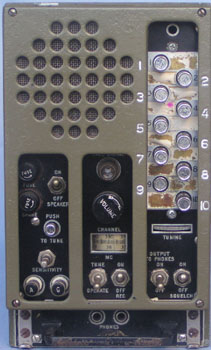
There are two groups of frequency ranges, 20.0 - 27.9 Mhz and 27.0 - 38.9 Mhz, of which the BC 683 belongs to the later. Various combinations of equipment were assembled for specific tasks, consisting of BC 604 (Tx) and BC 603 (Rx) for the low frequency range and BC 684 (Tx) and BC683 (Rx) for the high frequency range. There is also an intercom amplifier, which is the same physical size as the receiver, which is installed in vehicles requiring intercom facilities.
The receivers are calibrated every 100 kc and have the capacity to operate on CW as well as FM. The receivers are tunable and also have 10 pre-set press button frequencies, which can be changed if required. (The transmitters are xtal controlled, using the white topped FT 241 crystals,which have fundamental frequencies below the broadcast band - the ones used to make 455 kc xtal filters!) The actual frequencies are in the range 375 - 540.277 kc for BC684. Deviation on transmit is 40 kcs. Output power is 20 - 35 watts.
The receiver IF is 2.65 Mhz.
The BC683 has an RF stage, mixer, oscillator, 2 x IF amps, limiter, discriminator, BFO, AVC & squelch amps and 2 stages of audio, with in built loudspeaker. The equipment is well built and reasonably easy to work on.
The tuning range covers the 27mhz CB band, 28mhz and the cordless phone allocation just above 30mhz, along with government frequencies higher up.
© Ian O'Toole, 2009. Page created: 28/04/03 Last updated: 4/12/2009